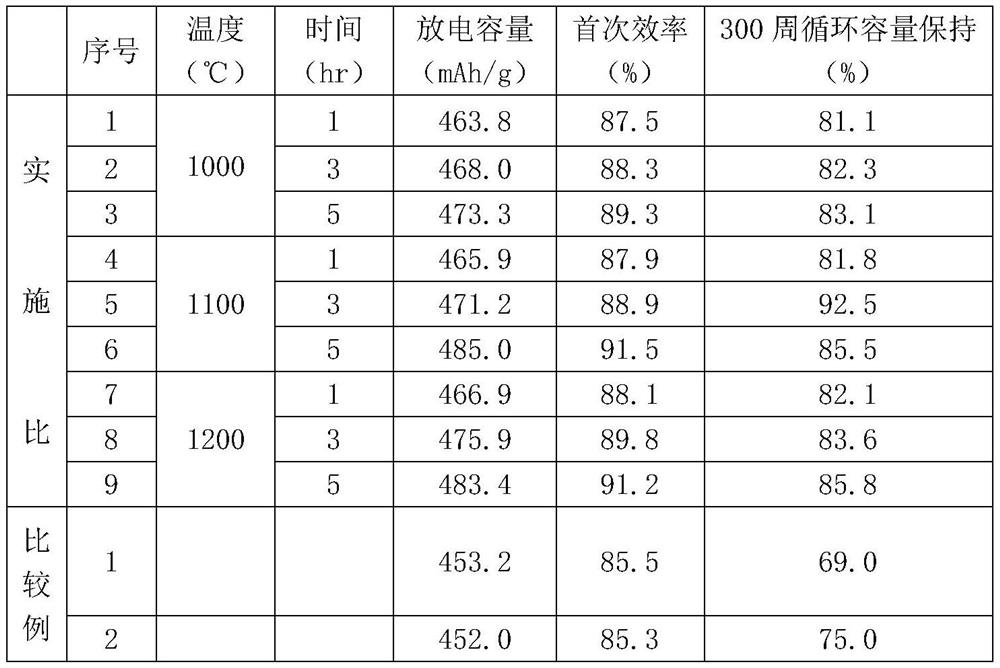A kind of lithium ion battery, used silicon carbon negative electrode material and preparation method thereof
A technology of negative electrode material and silicon-based material, applied in battery electrodes, secondary batteries, circuits, etc., can solve the problems of insufficient density, uniformity, poor battery cycle performance, and inability to meet battery energy density requirements.
- Summary
- Abstract
- Description
- Claims
- Application Information
AI Technical Summary
Problems solved by technology
Method used
Image
Examples
preparation example Construction
[0029] A method for preparing a silicon-carbon negative electrode material according to the present invention comprises the following steps:
[0030] 1) Kneading and mixing the slurry containing nano-silica powder or nano-silicon oxide powder with micron graphite powder and coal tar soft pitch; the weight percentage of each component is as follows:
[0031] Slurry containing nano-silica powder or nano-silicon oxide powder: 5-30wt%;
[0032] Micron graphite powder: 30-45wt%;
[0033] Coal tar soft pitch: 40-55wt%;
[0034] 2) coking the mixture prepared in step 1) to obtain graphite pitch coke containing silicon-based materials;
[0035] 3) pulverizing the graphite pitch coke containing the silicon-based material prepared in step 2) to obtain the graphite pitch coke powder containing the silicon-based material;
[0036] 4) Perform surface chemical vapor deposition treatment on the graphite pitch coke powder containing silicon-based materials prepared in step 3) to obtain a s...
Embodiment 1
[0054] In this embodiment, the percentage by weight of each component in the silicon-carbon negative electrode material is: slurry containing nano-silicon powder or nano-silicon oxide powder: 18wt%; micron graphite powder: 38wt%; coal tar soft pitch: 48wt% %;
[0055] The silicon-based material 4wt% graphite pitch coke powder prepared after step 1)-step 3) of the present invention is classified to form coke powder particles with an average particle diameter of D50=12.0 μm;
[0056] Put the coke powder particles into the rotary furnace, and use the CVD method for surface chemical vapor deposition treatment. The whole process is protected by nitrogen gas. The temperature of carbon deposition is 1000 ℃, and the time of carbon deposition is 1 hour. After the heat preservation is completed, it is cooled to room temperature with the furnace, and finally obtained Silicon carbon anode material.
[0057] The silicon-carbon anode material prepared in this example was tested, and the in...
Embodiment 2
[0059] In this embodiment, the percentage by weight of each component in the silicon-carbon negative electrode material is: slurry containing nano-silicon powder or nano-silicon oxide powder: 18wt%; micron graphite powder: 38wt%; coal tar soft pitch: 48wt% %;
[0060] The silicon-based material 4wt% graphite pitch coke powder prepared after step 1)-step 3) of the present invention is classified to form coke powder particles with an average particle diameter of D50=12.0 μm;
[0061] Put the coke powder particles into the rotary furnace, and use the CVD method for surface chemical vapor deposition treatment. The whole process is protected by nitrogen gas. The temperature of the deposited carbon is 1000 ° C, and the deposition time is 3 hours. After the heat preservation is completed, it is cooled to room temperature with the furnace, and finally Silicon carbon anode material.
[0062] The silicon-carbon anode material prepared in this embodiment was tested, and the initial disc...
PUM
| Property | Measurement | Unit |
|---|---|---|
| particle diameter | aaaaa | aaaaa |
| particle diameter | aaaaa | aaaaa |
| particle size | aaaaa | aaaaa |
Abstract
Description
Claims
Application Information
 Login to View More
Login to View More - R&D
- Intellectual Property
- Life Sciences
- Materials
- Tech Scout
- Unparalleled Data Quality
- Higher Quality Content
- 60% Fewer Hallucinations
Browse by: Latest US Patents, China's latest patents, Technical Efficacy Thesaurus, Application Domain, Technology Topic, Popular Technical Reports.
© 2025 PatSnap. All rights reserved.Legal|Privacy policy|Modern Slavery Act Transparency Statement|Sitemap|About US| Contact US: help@patsnap.com

